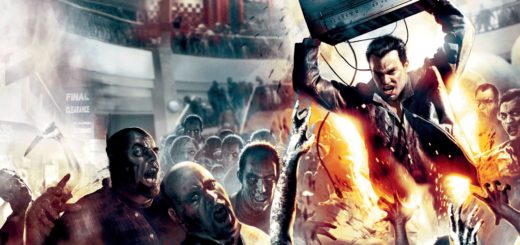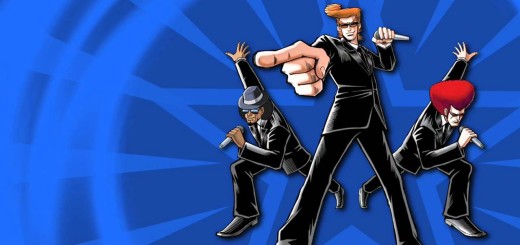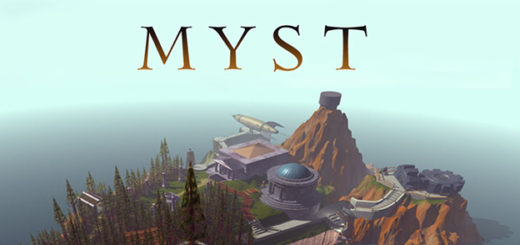Classic Callback: FIRE EMBLEM
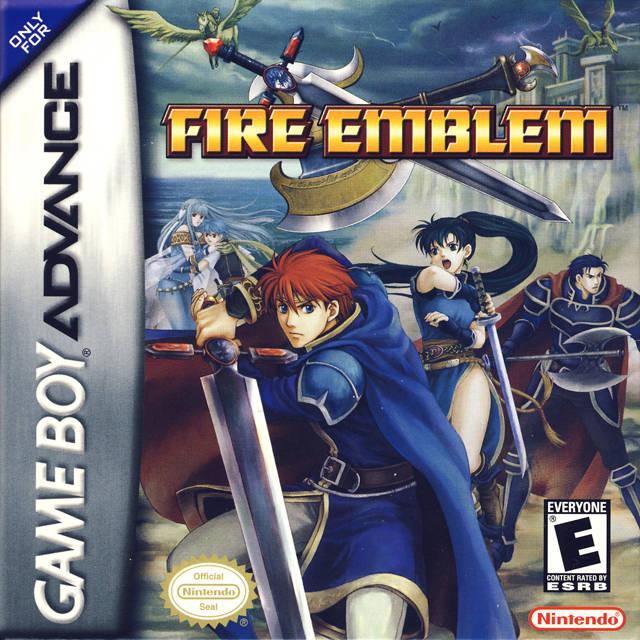
Mobile gaming these days is a far cry from the handheld era of my youth. Nintendo’s expert (and iron) grip on the market once defined portable gaming, but times have changed. Handhelds like the Gameboy Advance I grew up with now feel outmoded, having given up the ghost to more ubiquitous, versatile devices. Today, the most graphically demanding, multi-disc gaming epics of yesteryear like FINAL FANTASY IX run smoothly on basic smartphones, and games developed exclusively for mobile like PUZZLE AND DRAGONS have warped the prevailing format around bite-sized mini-games that people can complete in a matter of minutes. Even Nintendo, once a staunch detractor of the flourishing mobile market, has decided to enter the fray with successful offerings like POKEMON GO, SUPER MARIO RUN, and, more recently, FIRE EMBLEM HEROES, a game that takes many of its parent series’ core concepts and adapts them surprisingly well to the new mobile landscape. Still, a mobile endeavor like HEROES doesn’t hold a candle to the game that opened my eyes so many years ago: FIRE EMBLEM: THE BLAZING BLADE, known in the U.S. simply as FIRE EMBLEM. With its easy to understand yet difficult to master mechanics, and extraordinarily charming cast of characters, FIRE EMBLEM utterly reshaped my idea of a complete gaming experience. I hadn’t looked at portable games with attention to the details that made them great before. Looking back, I can confidently say that it is the one that sparked that appreciation for nuance and intricacy.
For those unaware, the Fire Emblem series has been around since Nintendo’s golden age in the ‘90s, and is often credited with popularizing the tactical RPG genre that inspired masterworks like FINAL FANTASY TACTICS (although it never saw an overseas release until 2003). The series’s immense popularity in Japan led Nintendo to include its first hero, Marth, and its then-latest protagonist, Roy, in SUPER SMASH BROS. MELEE, itself a smash hit. Overwhelmingly positive fan reaction to the sword-swinging duo overseas finally gave Nintendo the push they needed to develop its seventh entry for a worldwide release. However, despite warm critical and fan reception in the U.S. to the games that followed, the series faced cancellation back in 2010 due to declining sales before the timely release of the exceptional FIRE EMBLEM AWAKENING in 2012. This led to a revitalization of the franchise, paving the way for the numerous new titles currently in development.
At a glance, FIRE EMBLEM’s core gameplay is simple. Players assume the role of a tactician, assembling an army of unique characters with various strengths and weaknesses and directing them in turn-based combat across large, detailed maps, with the main narrative presented before and after each battle. Unlike FINAL FANTASY TACTICS or DISGAEA, which often feel like contests of raw strength with stats being the deciding factor, success depends largely on tactical superiority. No single unit feels overpowered and every problem has numerous solutions.
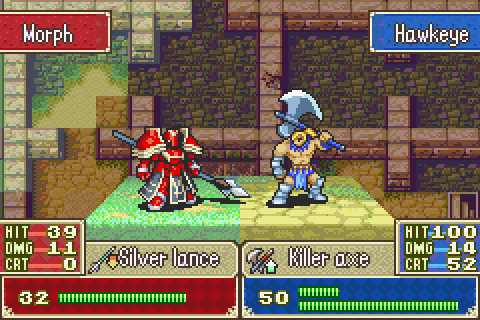
Dabbin’ on ‘em is one such solution
It sounds easy enough, but there are a few twists, like random stat gains and limited weapon durability. The most important of these twists is permanent death: losing a unit in battle means they’re gone for good. Deaths cannot be reversed except by abandoning progress and restarting a chapter, so one key character’s death could mean losing a large chunk of progress on a particularly tough map. Units are in very real danger early and often, meaning every individual move carries potential long-term repercussions, like fits of table-flipping rage and console resets when a beloved ally bites the dust. The chess-like forethought required to be successful makes clearing even early chapters unscathed feel rewarding.
As fantasy plots go, FIRE EMBLEM doesn’t exactly exude originality. The three main characters, the Lycian nobles Lyn, Eliwood, and Hector, unite to prevent the vengeful Nergal and his mysterious organization, the Black Fang, from enacting his plan to steal peoples’ life force to revive fire dragons from extinction and bring about calamity. While the story isn’t necessarily lacking (there are a couple of nice surprises), the narrative relies heavily on character development to truly shine.
The cast is what defines FIRE EMBLEM and has always elevated it past its strategic brethren; each member of the player’s army has distinct traits and mannerisms that make them so much more than faceless tools of destruction. Eliwood is a profoundly plain fantasy hero, but his traditional heroic goodness and naivete magnify his charm. Hector is a brash, hulking, charismatic axe-wielder who follows Eliwood to help him bear the burden of saving the world. Lyn rounds out the main trio as a confident, loyal nomad-turned-noblewoman responsible for introducing the player avatar to the rest of the army.
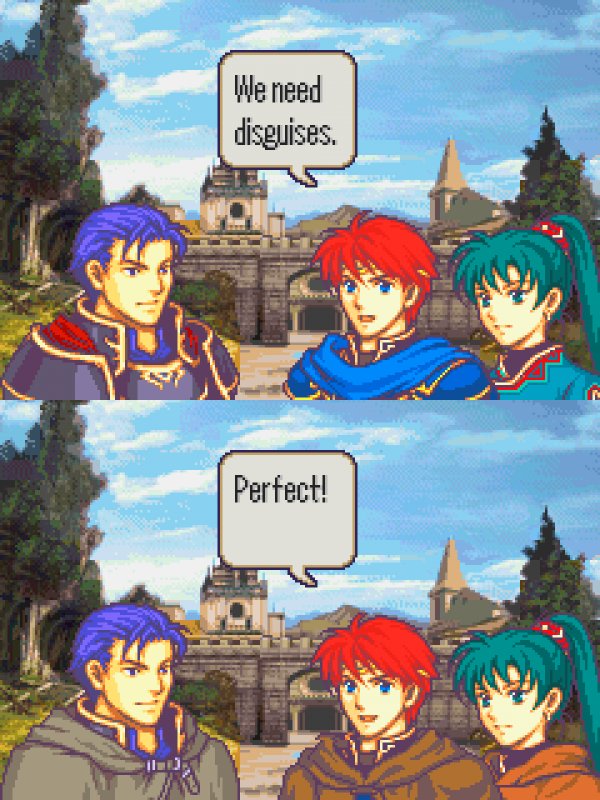
Not the brightest bunch, though
This emphasis on the characters impacts both the story and gameplay. Losing units forever feels personal when everybody has irreplaceable talents and a one-of-a-kind presence among their comrades, and the game’s epilogue even has subtle changes based on who survives. I found it hard not to have favorites based on identity alone, in-battle utility be damned (Matthew, I’m looking at you). Many of them have established relationships or pasts, and deploying certain units during certain chapters can determine whether or not enemies or NPCs can be recruited. Using Matthew in an early chapter makes Guy, arguably one of the strongest swordsmen in the game, recruitable because Guy owes Matthew a life debt for feeding him when he was starving. Lore and background tidbits like this are crucial when the plot is comparatively threadbare; most of the foot soldiers in the allied forces don’t have a large impact on the overall progression of the plot, so the bulk of their exposition comes in the form of the Support system, another series mainstay.
By placing characters next to each other in battle, they establish a rapport with one another, and after enough time spent together, they have conversations that reveal each person’s individual backstory. It’s a grounded, day-to-day personal element that has in-battle significance; units who have high support ranks with one another gain bonuses to their stats whenever a friend is nearby. Some characters can even get married, further enhancing the game’s ending. Like FIRE EMBLEM’s myriad other commendable design choices, the logic behind the support concept is clear and well-executed compared to similar gameplay ideas, such as PERSONA 4’s Social Link system, whose advantages require a bit more effort from the player to capitalize on. The support system is so widely acclaimed that entire subgroups of the series’s fans devote their playthroughs to pairing their favorite characters together. This becomes a fun, social, metagame aspect that emotionally connects players to the ragtag group they’re commanding and bonds like-minded fans over their forays into virtual matchmaking.
Nintendo and Intelligent Systems’ painstaking attention to detail is apparent in every corner of this 32-bit epic, right down to the fluid sprite animations and vividly-colored maps. At roughly 36 chapters, the main campaign took me about 21 hours to complete, not counting all of the hours I wasted on futile efforts that concluded with me losing a unit and walking across the room to pick my Gameboy up (thank Nintendo for the GBA SP’s clamshell design). Recent titles AWAKENING and FIRE EMBLEM FATES have become increasingly accessible with the inclusion of easier difficulty modes and the option to disable the permanent death mechanic that once defined the series, while maintaining the deft use of characters to propel the narrative and motivate players that made the introductory FIRE EMBLEM so great. Its availability is pretty limited, but it’s worth it to break out the old GBA for this classic.
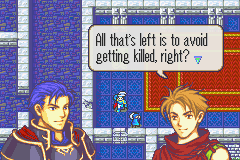
Ha, good luck with that
Source: Screenshot
FIRE EMBLEM and its unconnected sequel, FIRE EMBLEM: THE SACRED STONES, are both available on the Gameboy Advance and on the Wii U eShop.

